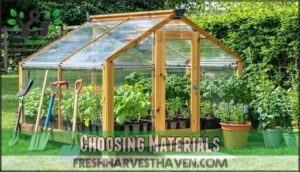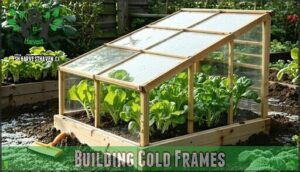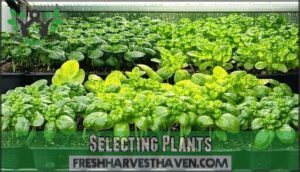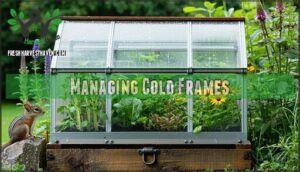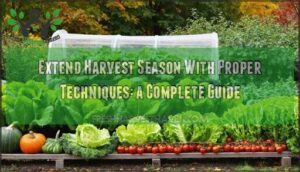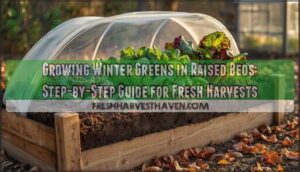This site is supported by our readers. We may earn a commission, at no cost to you, if you purchase through links.
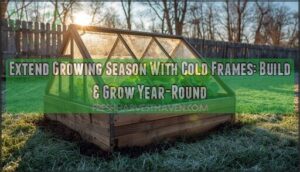
These simple boxes, topped with clear panels, let you harvest crisp greens when most folks are stuck waiting for spring.
Picture planting kale in October, then plucking it fresh while frost glistens outside. It’s practical, affordable, and honestly, kind of makes you feel like a gardening wizard.
Cold frames cut the chill, hold in soil warmth, and block icy winds—turning your backyard into a four-season experiment.
Ready to outsmart winter? There’s more to discover, and with cold frames, you can have a cozy blanket for your plants.
Table Of Contents
- Key Takeaways
- Cold Frame Basics
- Choosing Materials
- Building Cold Frames
- Selecting Plants
- Managing Cold Frames
- Frequently Asked Questions (FAQs)
- Can a cold frame extend your gardening season?
- How can I extend my harvest season?
- How do I protect my greenhouse from cold weather?
- Can you extend your gardening season?
- How do I Keep my Garden warm in the winter?
- How long does a greenhouse last?
- When should you plant in a cold frame?
- What are the disadvantages of a cold frame greenhouse?
- How to use a cold frame in summer?
- How can I extend my growing season?
- Conclusion
Key Takeaways
- You can outsmart frost and keep your harvest rolling by building a simple cold frame that traps warmth and protects your greens.
- Place your cold frame in a sunny, south-facing spot to maximize heat, and choose rot-resistant wood and clear panels for durability.
- Hinged lids and good ventilation let you control temperature and humidity, keeping plants cozy—not cooked or soaked.
- Fill your cold frame with cold-hardy crops and start seedlings early, so you’ll have fresh veggies when others are waiting for spring.
Cold Frame Basics
You can transform your garden into a year-round growing machine by building a simple cold frame that acts like a mini greenhouse.
This box-like structure with a transparent lid creates a protective microclimate that’s 1-2 hardiness zones warmer than your outdoor conditions, letting you grow fresh vegetables even when frost threatens.
You can transform your garden into a year-round growing machine by building a simple cold frame that acts like a mini greenhouse.
This box-like structure with a transparent lid creates a protective microclimate that’s 1-2 hardiness zones warmer than your outdoor conditions, letting you grow fresh vegetables even when frost threatens.
What is a Cold Frame
Every savvy gardener knows a cold frame is the secret to stretching your harvest.
A cold frame lets you harvest fresh greens long after others think the season’s done.
Think of it as a rugged box with a clear “mini greenhouse” lid, parked right over your soil.
This simple Cold Frame Design captures enough warmth to bump the temperature inside by up to 15°F, creating a cozy microclimate.
With a cold frame, you’ll dodge early frosts, give seedlings a head start, and dabble in season extension—all without breaking the bank.
Benefits of Cold Frames
Gardeners know cold frames are magic boxes for Crop Protection and Season Extension.
With a little effort, you’ll shield your plants from chill, wind, and garden pests, all while warming your microclimate for bigger harvests. Imagine crunching fresh lettuce in late fall—frost prevention makes it possible!
- Extend growing season to enjoy fresh produce longer
- Increase yield with early and late plantings
- Boost cold frame gardening success through superior frost protection
Ideal Placement and Orientation
After sizing up the perks of cold frames, it’s time to pick the sweet spot for yours.
South facing is your best bet—think of it like giving your plants a front row seat to the sunlight show.
Aim for full sunlight exposure and angle the lid to sip morning rays, boosting soil temperature for early starts.
Place your frame near a building or sturdy fence to pocket a microclimate and shield young sprouts from frost-nipping winds.
A slight south-facing slope helps with drainage and keeps warmth in, letting you stretch the growing season.
Adjust the frame positioning as the winter sun drops.
Smart garden placement is the difference between microclimate gardening and frostbitten disappointment, making it a crucial step in ensuring the success of your cold frame, and ultimately, the growing season.
Choosing Materials
When you’re picking materials for your cold frame, it’s worth thinking about how much weather each part will face, since sturdy wood and clear coverings can really make a difference.
You don’t have to be a master carpenter—just make sure your frame resists rot and your top lets in plenty of sun, so your plants don’t complain about the accommodations.
Wood Frame Options
When you’re picking wood for your DIY cold frame, there’s plenty to chew on.
Choosing the right wood is where your DIY cold frame’s story really begins—pick smart for a frame that lasts.
Frame durability starts with smart wood selection—think cedar or redwood for resistance against rot and bugs.
Pine works, too, but treat it right or you’ll spend weekends patching.
Reclaimed wood adds character and can save a buck.
For high-quality frame designs and easy maintenance, keep these tips handy:
- Choose rot-resistant lumber
- Insulate dense wood
- Prioritize wood treatment
- Consider reclaimed options
- Plan sturdy frame construction
Understanding cold frame benefits is vital for a successful garden with proper maintenance.
Glass or Plastic Coverings
When you’re weighing glazing options for your cold frame, think of the lid as the window to plant success.
Glass panels let in the most light, but they’re heavy, fragile, and tricky when managing condensation.
Transparent tops made with polycarbonate sheets or clear plastic give you a lighter, safer alternative, with better insulation and durability.
Double-wall polycarbonate retains heat far better than single-layer plastic sheets, making these cover materials a practical choice for most transparent lids.
Considering the benefits of proper glazing types is essential for optimizing plant growth and protection.
Rot-Resistant Lumber
Longevity in your cold frames starts with smart rot-resistant lumber choices. Here’s your quick guide:
- Cedar options top the list—naturally durable and no chemicals needed.
- Redwood uses shine for long-lasting garden structures but can pinch your wallet.
- Cypress balances cost and decent weather resistance.
- Pressure treated lumber offers a budget path, though some prefer natural wood.
- Composite materials and bamboo alternatives suit DIY gardening projects for eco-minded folks.
Don’t forget, well-draining soil matters as much as sturdy lumber. If the frame sits on soggy ground, even the best carpentry skills can’t save your plants.
For best results, consider using cedar lumber products to build your cold frames, ensuring a long-lasting garden structure with naturally durable materials.
Building Cold Frames
Building a cold frame is simpler than assembling a backyard shed and gives you the chance to grow fresh greens even when your neighbors are busy scraping frost off their windshields.
With a few basic materials and some careful placement, you’ll create a sturdy structure that shields your plants from cold nights and sudden chills.
Building a Cold Frame
When you’re ready to roll up your sleeves and get started with DIY construction, start with simple, sturdy frame design.
Cedar or salvaged boards go the distance, holding up through many a wild season. Level your ground or stack a few concrete blocks—solid footing keeps your cold frames steady.
Take special care with those corners; they do all the heavy lifting. If you want to get fancy, cold frame kits and garden cloches come ready-to-assemble, offering hassle-free season extension and easy cold frame extensions.
Understanding cold frame benefits is vital for a successful gardening experience with cold frames and to achieve season extension.
Hinged Lids and Ventilation
Adaptability is key in the context of cold frames, and hinged lids are the heart of smart temperature control.
Use strong strap or piano hinges to attach your lid materials—glass, polycarbonate, even recycled windows.
To avoid accidental plant steam baths, consider automatic venting systems that open once things get toasty, hitting 75°F or above.
Prefer hands-on? Manual ventilation tips include cracking the lid slightly on sunny days for better air circulation.
Good hinged lids make your cold frame’s ventilation strategies far easier to manage.
Properly designed cold frames often incorporate cold frame lids to regulate temperature and humidity, which is crucial for smart temperature control and overall cold frame management.
Drainage and Insulation
Even if you’ve built the snazziest cold frame on the block, don’t let soil moisture become your Achilles’ heel. Add a gravel layer for water runoff, sink the frame for extra thermal mass, and wrap the inside with bubble wrap.
Insulation materials and smart drainage systems equal happy plants and smooth temperature regulation. Moisture management is half the battle.
- Gravel underneath boosts drainage
- Bubble wrap locks in warmth
- Soil insulation prevents root chills
- Weather stripping blocks drafts
- Sloped lids send water packing, ensuring smooth temperature regulation
Selecting Plants
In the case of filling your cold frame, you’ll want to choose plants that can handle cooler temperatures or give tender seedlings a head start before outdoor planting.
Picking the right varieties means you won’t be staring at empty dirt all winter, and you might even impress your neighbors with your off-season harvest, by selecting plants that thrive in these conditions and provide a head start.
Cold-Tolerant Vegetables
Some vegetables don’t just survive winter—they thrive in it.
Cold-tolerant vegetables love chilly weather, using frost to boost flavor and freshness.
Put your cold frame to work with these all-stars:
- Leafy greens like kale and lettuce varieties sweeten after frost for your winter salads.
- Broccoli growth practically speeds up when the air turns crisp.
- Spinach care is simple: shelter it, pick, repeat.
- Root crops such as carrots and beets become sweeter as the mercury drops.
Season extension with cold frames makes winter gardening a breeze.
For the best results, research cold hardy vegetables to maximize your winter harvest.
Seasonal Flowers
A smart cold frame lets you enjoy colorful seasonal flowers in every season, not just spring.
Pansies and primroses add pep to early blooms, while mums and asters outsmart autumn frost for lasting color.
From planning your garden designs to managing petal care and blooming times, here’s a quick table to keep your cold frame floral show on cue:
| Flower | Blooming Times |
|---|---|
| Pansies | Early Spring, Fall |
| Primroses | Spring |
| Mums | Late Fall |
| Asters | Fall |
This table helps with managing petal care and ensures your cold frame remains a vibrant display of flowers throughout the year, making it a valuable tool for gardeners who want to enjoy seasonal flowers in every season.
Plant Hardening and Seed Starting
A trusty cold frame is your secret weapon for seed starting and plant hardening. It’s all about gradual plant acclimation—open the lid on mild afternoons, then leave it slightly ajar overnight.
Seedling care here means less transplant shock and hardier roots. Seed germination jumps ahead, and you’re safe from late frosts.
Rotate crops for resilience. Before you know it, your seed trays will be overflowing.
- Faster seed germination
- Gentle plant acclimation
- Reliable frost protection
- Smoother crop rotation
- Easier hardening off plants
Managing Cold Frames
Managing your cold frame means you’ll need to pay attention to temperature, moisture, and the occasional ambitious squirrel.
With a little effort, you can keep plants thriving in their sheltered nook, stretching your garden season well beyond the usual limits.
Temperature Control and Ventilation
A cold frame’s climate management depends on thermal regulation and good ventilation systems.
Use a thermometer to check internal heat daily, propping the lid up 6–8 inches when your temp tips over 75°F. Automatic vents make air circulation a breeze, especially when life gets busy.
Add insulation during icy snaps to boost heat retention—a winter task as routine as scraping car windows.
- Maintain steady airflow
- Adjust ventilation controls daily
- Monitor sudden heat spikes to ensure proper ventilation systems are in place.
Humidity and Moisture Management
After mastering temperature control, tackling humidity and moisture management keeps your plants out of sticky situations.
Check soil moisture often—too much and roots sulk, too little and leaves wilt. Aim for water balance by using gentle garden watering techniques and cracking open vents for humidity control.
Watch for lingering fog and mold on leaves. Use this cheat sheet for daily upkeep:
| Task | Frequency | Tool Needed |
|---|---|---|
| Check Soil | Every 2 days | Moisture Meter |
| Vent Lids | Daily | Hinged Lid |
| Scan Leaves | Weekly | Magnifier Glass |
To ensure the health of your plants, it is crucial to follow these guidelines carefully, maintaining a balance between moisture and humidity control, and regularly checking for signs of distress, such as mold on leaves.
Pest Control and Maintenance
If your soil starts feeling like a soggy sponge, it’s time to switch gears and focus on pest prevention. Strong garden pest control boosts plant health and keeps unwanted bugs out.
Rely on these five basics:
- Seal gaps for pest deterrents.
- Rotate crops for soil health.
- Clean for weed control.
- Scout often for disease prevention.
- Invite beneficial insects using natural repellents.
Garden cleanliness is key—think of it as a shield, not a chore! Effective natural pest management techniques can also enhance your garden’s overall health. Natural repellents are a great way to keep your garden safe.
Frequently Asked Questions (FAQs)
Can a cold frame extend your gardening season?
A cold frame can stretch your gardening season by weeks or even months.
It shields plants from frost, keeps things a bit warmer, and lets you sneak in early spring crops or keep growing late into fall, which can be a bit warmer.
How can I extend my harvest season?
Think of your garden as a marathon runner—don’t let it tire out early.
Try using row covers, mulch, and staggered planting.
Cold frames add bonus time, letting you pick fresh veggies well into fall.
How do I protect my greenhouse from cold weather?
Insulate with bubble wrap or thermal blankets, seal up drafts, and use a small heater if needed.
Crack the vents for air flow.
You’ll get plants that survive even when it’s colder than a snowman’s handshake outside.
Can you extend your gardening season?
You bet—you can keep your gardening season rolling well past the first frost.
By using cold frames or similar cover, your veggies get a cozy microclimate, letting you outsmart the calendar and harvest even when temperatures drop.
How do I Keep my Garden warm in the winter?
Cover delicate plants with cold frames, mulch, or row covers, and seal out drafts at night.
Water in the morning to trap warmth.
Bubble wrap and old blankets make great insulators—your garden will thank you, frost or not.
How long does a greenhouse last?
Like a pair of sturdy boots, a greenhouse usually lasts 10 to 20 years if you keep up with small repairs.
Keep the frame clean, check for cracks, and replace panels as needed to help it last longer.
When should you plant in a cold frame?
You’ll want to plant in a cold frame a few weeks before your last expected frost.
Cool-season crops like lettuce, spinach, and kale thrive.
Think of it as giving your garden a head start against Jack Frost.
What are the disadvantages of a cold frame greenhouse?
Back in the Stone Age, cold frames seemed magical, but you’ll find they often overheat.
They lack space for tall plants, and require daily check-ins.
They’re not great for tropical veggies, and heavy snow can ruin your lid.
How to use a cold frame in summer?
Keep the lid open or remove it, letting plants bask in fresh air while still protected from sudden storms.
A cold frame in summer acts like a sunhat—shielding delicate crops from harsh midday rays and sneaky critters.
How can I extend my growing season?
To give your harvest a head start, sow hardy crops early, use cold frames for warmth, and swap in new seedlings as the season shifts.
Think of it as turning your veggie patch into a backstage pass for plants.
Conclusion
Imagine your backyard in January, with lettuce thriving under that homemade “blanket”—a simple cold frame.
When you extend growing season with cold frames, you’ll harvest greens long after neighbors pack up their gardens.
Just remember to monitor temperature, crack the lid for fresh air, and pick rot-resistant building materials.
These low-tech boxes turn anyone into a smart gardener, making each crisp salad in winter a reminder that you’ve beaten the seasons at their own game.

